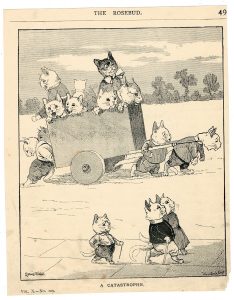
Vintage print, Cats, by Louis Wain, credit Antiche Curiosità©
Mary Blindflowers©
.
Louis Wain, illustratore inglese
.
Louis William Wain (5 August 1860 – 4 July 1939), illustratore inglese, nacque a Clerkenwell, sobborgo di Londra. Wain, noto anche come il pittore dei gatti, era figlio di un commerciante di tessuti, l’unico maschio in una famiglia di cinque sorelle, nessuna delle quali si sposò.
Wain fu uno dei primi ad antropomorfizzare gli animali in illustrazioni che li ritraevano in vari atteggiamenti umani, leggendo, tirando carretti, giocando, bevendo il the, etc. Le sue illustrazioni divennero popolarissime nell’Inghilterra vittoriana. “Ha fatto il gatto suo”, ha osservato una volta H.G. Wells. “He made the cat his own, He invented a cat style, a cat society, a whole cat world”.
Wain fece varie illustrazioni per libri di bambini come Madame Tabby’s e riviste tra cui L’Illustrated Sporting, il Dramatic News, il The Illustrated London News e il The Rosebud. Le prime illustrazioni erano sicuramente più sobrie e tradizionali rispetto a quelle sull’umanizzazione dei gatti, perché doveva assecondare le richieste degli editori. I due pescatori disegnati per il The Rosebud, (vol. X, n. 115), dovevano illustrare una favola:
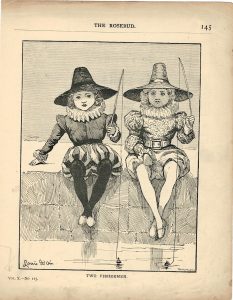

Vintage Print, Two Fisherman, 1890, credit Antiche Curiosità©
“Once upone a time there were two little boys who wanted to give their mother a surprise. She had gone out for the day. “Wouldn’t it be nice” they said, “to go and cath some fisch for her supper? So they made some fishing-rods with sticks, string, and corks, and they put sharp hooks below the corks, and then quite forgot the bait to hide them! They sat a long time quite quit, watching, and thinking how pleased their mother would be with the large dishful they were going to catch…”
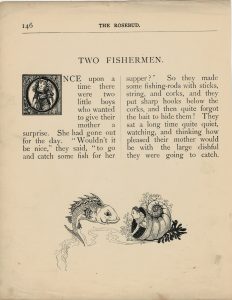

Vintage Print, Two Fisherman, 1890, credit Antiche Curiosità©
Non tutti i gatti erano umanizzati. In alcune illustrazioni venivano rappresentati tradizionalmente come elemento accessorio in diversi contesti con altri animali o persone. Nei vari numeri di The Rosebud, abbiamo esempi lampanti di questo. Per illustrare “A stitch in time save nine”, Wain rappresenta due bambine che cuciono un arazzo:
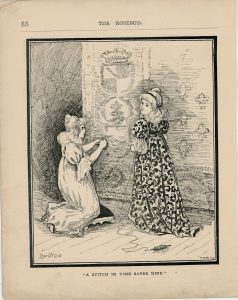

Vintage Print by Louis Wain, 1890, credit Antiche Curiosità©
“Long tim ago little girls did not learn many lessons, mor did they run about very much, but they were taught to do all sorts of needlework very neatly. The ladies sat at home a great deal then, and amongst ither things they made beautiful woolwork hangings, called tapestry, to cover the walls of the rooms instead of paper, as we have now. The little girls who helped to make the hangings must have been pleades to see the patterns and figures grow, ad each day a little more of the work was done. Sometimes holes would come in the tapestry: perhaps a little mouse had nibbled it, ora a naughty cat scratched it;or perhaps the tapestry was old, and a careless little child hiding behind had been too rough with it – anyhow, these little girls seem to be mending a hole at once, so that it may not grow into a large ugly one – F. E”.
Per illustrare “Not at home”, The Rosebud (Vol. X, n° 114) Wain disegna un maiale e quattro cani:
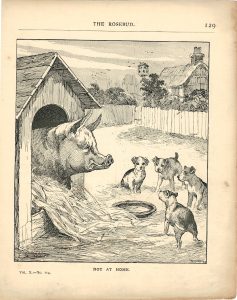

Vintage print by Louis Wain, 1890, credit Antiche Curiosità©
“First of all the puppies went out to play. They scrambled round the barn, rolled over in the hay, barked at the chickens, and mixed themselves up in everything. Next, their mother said: “Yes” when the farmer came and said, “Juno, old girl, come for a walk? Those puppies of yours can look after themselves for an hour or two”. And Juno enjoyed her walk, as dear doggies do, and little thought what was going on at home!
For Mrs. Pig, out for a morning stroll, saw a very comfortable stye, as she thought, empty-plenty of straw, nice smell of bones about it-so she went in to rest.
Presently back came the puppies to tell their mother all they had seen and done.
“Our mother doesn’t snore like that”, said one. “And she hasn’t such a long nose”, said another. And they all started back in terror as Mrs. Pig, awakened by the whinings, squeaks, and yap-yap.pings, put her head out of their own front door and grunted, “What do you want?”
Poor, tired, hungry, frightened little puppies! Mother was out, and Mrs. Pig was in. But Juno very soon came back, and then you can guess what happened. Mrs. Pig was (very quickly) out, and Mother Juno was in! -F.E.”
Wain disegnò anche immagini ispirate all’oriente per “Koto’s Flowers”, sempre in The Rosebud, dove si nota una donna giapponese inginocchiata su una stuoia, e parte di un interno con elementi tradizionali nipponici:
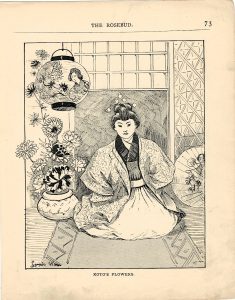

Vintage Print by Louis Wain, 1890, credit Antiche Curiosità©
“Her name was Koto-at least, that was one of her names, for, like most Japanese people, she had several. Her home was far away from England, across the sea, in that wonderful country called japan.
Koto loved to hear stories about England. She liked to hear how the ladies dressed, and how they amused themselves, and she often wished she could see a real English garden, fot she dearly, loved flowers. When a child, she used to beg to be allowed to go down to a pond near her home, where the tall lotus flowers grew. Some of the children she played with used to take the large lotus leaves and hold them up for parasols, but Koto used to beg some one to cut down for her some of the lovely buds that were growing hight over her head; these she would take home with her in great delight – F.P.”.
Per illustrare invece A Catastrophe, (Vol. X n° 109 di The Rosebud), utilizza i famosi gatti vestiti come umani che tirano un carretto e passeggiano traquillamente per strada, mamma gatta (Mrs, Cati-Chat) con un vestitito femminile, il marito gatto con pantaloni e giacchetta e a seguire quello che sembra essere il loro figlioletto in camicia chiara e pantaloni scuri. Anche i cani erano antropomorfizzati, con cappelli a cilindro e vestiti da uomo. Fu nel 1886 che i suoi primi disegni con animali umanizzati furono pubblicati nel numero natalizio di Illustrated London News dal titolo A Kittens’ Christmas Party. I gatti raffigurati erano più di 150 su undici tavole. Con lo pseudonimo di George Henri Thompson, egli inoltre illustrò inoltre numerosi libri per bambini.



Vintage print, Cats, by Louis Wain, credit Antiche Curiosità©
Da cosa fu ispirato Wain?
La moglie che morì di cancro al seno, si era molto affezionata ad un gatto che aveva raccolto per strada, Peter. A lui erano dedicati i disegni di Wain, che continuò a disegnare anche dopo la morte della moglie, per adempiere ad una promessa che le aveva fatto. Era stata lei infatti ad incoraggiarlo. Peter, il gatto, fu il principale ispiratore di Wain: “To him, properly, belongs the foundation of my career, the developments of my initial efforts, and the establishing of my work”.
Nonostante il successo, Wain che soffriva anche di disturbi mentali, ebbe una vita tragica e difficoltà finanziarie per tutta la vita, dato che venne sfruttato e talvolta anche imbrogliato dai suoi editori. Si impegnò attivamente con molte associazioni benefiche a favore degli animali. Dal 1898 al 1911 fu presidente del National Cat Club.
I suoi lavori originali e le stampe dei suoi lavori sono molto ricercate dai collezionisti.
.
https://antichecuriosita.co.uk/il-destrutturalismo-punti-salienti/
https://www.youtube.com/watch?v=5kxVwDzPMM8

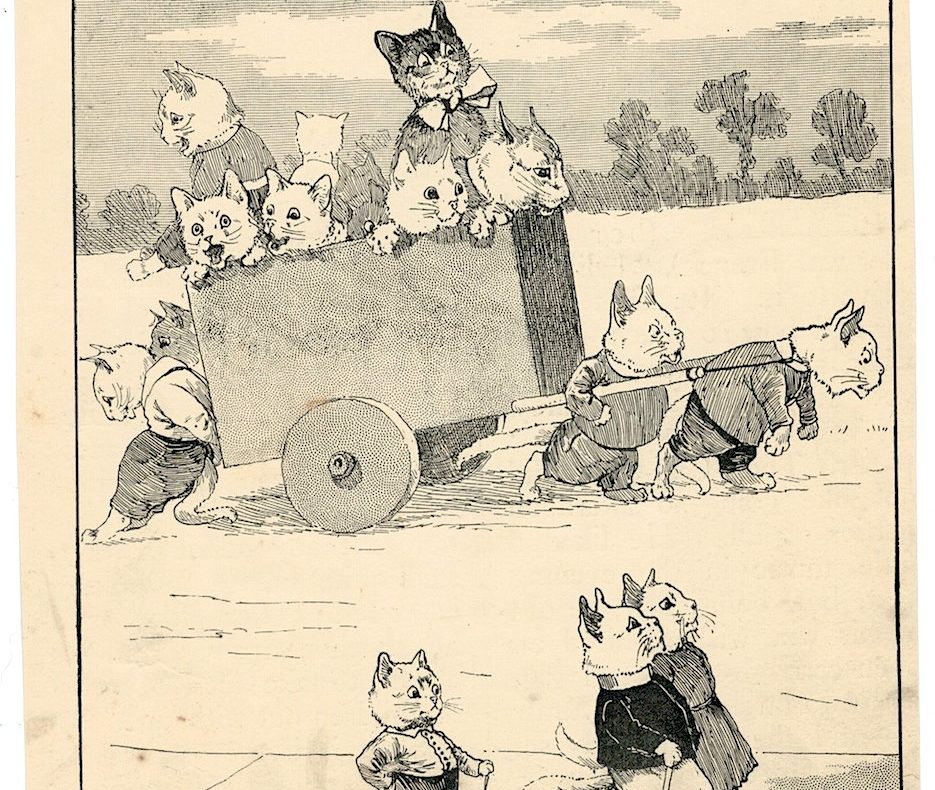
Ho due opere originali di Wain Louis
The Skaters
The village Hero
Original water color
Posso avere informazioni
Grazi distinti saluti Santin
Italy
Mi mandi una mail privata. Grazie.